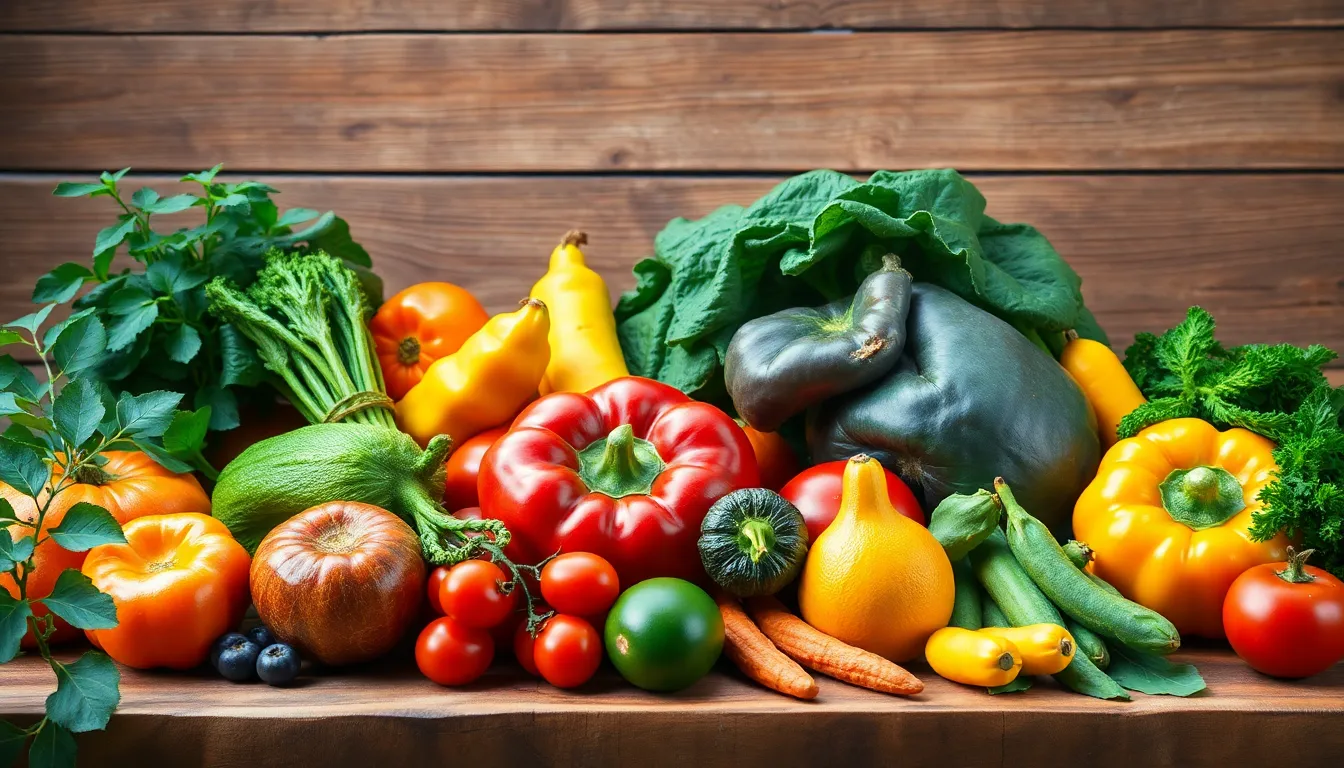In a world where kale can be a celebrity and avocados have their own fan clubs, organic produce is the VIP of the grocery aisle. It’s not just about being trendy; it’s about savoring the vibrant flavors and knowing that those fruits and veggies are grown without synthetic pesticides or fertilizers. Imagine biting into a juicy tomato that tastes like it just jumped off the vine—now that’s what organic living is all about!
But organic produce isn’t just for the health nuts or Instagram influencers. It’s for anyone who wants to enjoy food that’s as close to nature as possible. With a growing awareness of what goes into our food, more people are opting for organic options. So whether you’re a seasoned chef or a microwave magician, embracing organic produce can elevate your meals and make your taste buds dance. Who knew eating healthy could be this deliciously fun?
Table of Contents
ToggleWhat Is Organic Produce?
Organic produce refers to fruits, vegetables, and other plant-based foods cultivated without synthetic fertilizers, pesticides, or genetically modified organisms (GMOs). The USDA regulates organic farming practices, ensuring that crops receive natural methods such as crop rotation and composting. These practices aim to promote healthy soil and ecosystems.
Farmers grow organic produce using organic seeds and adhere to strict guidelines for maintaining organic status. For example, crops often thrive in healthier ecosystems, as organic farming encourages biodiversity and reduces chemical runoff. Naturally occurring substances enhance soil health, resulting in more nutrient-rich produce.
Consumers increasingly choose organic produce, driven by a desire for cleaner eating. Research indicates that many find organic fruits and vegetables flavorful and fresher than their conventional counterparts. The appeal of organic options extends to social and environmental considerations, with many seeking sustainable practices in their food choices.
Labels on organic products provide assurance to buyers regarding cultivation methods. The “USDA Organic” seal signifies that a product meets stringent standards for organic farming. Shoppers can find organic options at grocery stores, farmers’ markets, and local co-ops, making them accessible to a broader audience.
Choosing organic produce contributes to personal health and supports environmentally sustainable practices. Consumers engage more with local producers, often creating a stronger connection to the food they eat. Embracing organic options not only enhances meals but fosters a community mindful of environmental impact.
Benefits of Organic Produce

Organic produce offers numerous advantages that appeal to consumers focused on health and sustainability. The benefits of organic farming practices significantly extend beyond taste alone.
Health Benefits
Consuming organic produce leads to lower exposure to harmful chemicals. Research indicates that organic fruits and vegetables contain fewer pesticide residues, promoting a healthier eating experience. Nutrient density often appears higher in organic produce, contributing to better overall health. Organic foods commonly showcase higher antioxidant levels, which support immune function. For children and pregnant women, organic produce tends to reduce the risk of chemical exposure, aligning with current health recommendations. Selecting organic options supports a balanced diet centered on fresh and nutritious foods.
Environmental Impact
Organic farming promotes biodiversity by avoiding synthetic chemicals. Healthier soil arises from practices such as crop rotation and composting, fostering ecosystems that support various organisms. Less pollution results from organic techniques, reducing runoff of harmful substances into water supplies. Organic farms tend to use less water, improving sustainability in agriculture. Additionally, carbon sequestration in healthy soils mitigates climate change effects. Choosing organic produce thus contributes to a sustainable food system that prioritizes environmental well-being.
How to Choose Organic Produce
Choosing organic produce involves careful consideration and an eye for quality. Understanding what to look for can enhance the shopping experience.
Reading Labels
Reading labels provides essential information about organic produce. The “USDA Organic” seal guarantees that a product meets strict organic standards. Focus on ingredients; organic items should contain minimal additives. Look for specific terms such as “100% organic” for the purest options. Compare prices as organic products often vary in cost across different stores. Keep an eye out for local or small-scale producers as they may offer fresher and more environmentally friendly options.
Seasonal Considerations
Seasonal considerations enhance the choice of organic produce. Selecting fruits and vegetables in season ensures better freshness and flavor. Seasonal items often have lower costs compared to out-of-season alternatives. Inquire at local farmers’ markets for what’s currently available; local growers frequently offer organic options. Knowing the growing seasons for specific produce can enhance nutritional value and taste. Consider experimenting with recipes based on seasonal availability to maximize enjoyment and health benefits.
Common Myths About Organic Produce
Misconceptions about organic produce often circulate among consumers. One common myth suggests that organic fruits and vegetables lack significant nutritional benefits. Research indicates organic produce contains higher levels of certain nutrients, including antioxidants.
Another prevalent idea claims organic farming is merely a marketing tactic. In reality, rigorous USDA regulations enforce strict standards that govern organic farming practices. Consumers can trust the “USDA Organic” seal ensures compliance with these guidelines.
Some people believe organic produce lasts longer compared to conventional options. However, organic foods are less likely to contain preservatives, which can lead to quicker spoilage. Acknowledging the freshness factor, consumers should plan to use organic items soon after purchase.
There’s a notion that organic products are always pesticide-free. While synthetic pesticides are banned in organic farming, permissible natural pesticides are still used. It’s essential for consumers to understand this distinction when considering organic choices.
Cost remains a significant barrier for potential buyers. Organic produce often comes with a higher price tag, attributed to labor-intensive farming practices and lower yields. Shoppers may find local farmers’ markets offer more affordable organic options.
Additionally, many assume organic farming harms the environment less than conventional farming. Organic methods promote biodiversity and improve soil health, benefiting ecosystems. The environmental advantages of organic farming contribute to sustainable agricultural practices.
Finally, skeptics sometimes argue organic and conventional produce taste the same. Taste preferences vary widely, yet numerous consumers report organic fruits and vegetables offer richer flavors. Experimenting with organic options can enhance culinary experiences and promote healthier eating habits.
Choosing organic produce is more than just a dietary preference; it’s a commitment to health and sustainability. By opting for organic fruits and vegetables, consumers support farming practices that benefit both personal well-being and the environment. The vibrant flavors and nutrient density of organic options enhance meals while reducing exposure to harmful chemicals.
As awareness grows, so does the accessibility of organic produce through various outlets. Embracing organic foods not only enriches the eating experience but also fosters a deeper connection to local agriculture. With each choice, individuals contribute to a healthier planet and a more sustainable food system.



